The writer Gabriel García Márquez had frequent clashes with dictionaries and, in a column on fantasy and artistic creation, he once said: “On the contrary, and contrary to what the dictionary says, I think that imagination is a special faculty that artists have to create a new reality from the reality in which they live. That, moreover, is the only artistic creation that seems valid to me.” If we accept this premise, there is a group of scientists who meet all the conditions to be considered artists in their own right —for their eccentric hobby is painting using the bacteria, viruses and fungi that are the protagonists of their microbiology studies; they live in the reality of their laboratories, their Petri dishes and their microscopes.
This new club of scientific artists are the winners of the contest organized by the American Society for Microbiology: the Agar Art Contest, which since 2015 rewards the best works created with live microbes that grow on agar —a substance similar to gelatine and overflowing with nutrients. In this ground-breaking discipline, microbes (which serve as the paint) are planted on agar (which serves as a canvas), with the particularity of the also agar serving as food, which then grow in colonies that give shape to the idea the artist had in their mind. This all occurs in incubators that keep the bacteria warm and ready to multiply.
The technique
This living art is unique from almost any point of view: it could be lethal, for example, if the artist is infected with some especially pathological bacteria; but it is in the colour where a great part of its beauty lies. The microbes can be naturally coloured, like the bacterium Serratia marcescens (bright red, like something out of Matisse’s Red Room), or genetically modified to express a certain hue, like the yeast Saccharomyces cerevisiae (which, after incorporating violacein genes, becomes an elegant purple living paint).
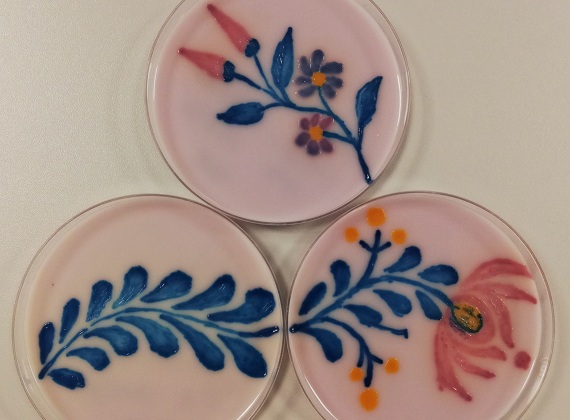
As different bacteria grow at different speeds and temperatures, the final result will only be seen at the end of the process: it will depend on the combination chosen for painting and the skill of programming and controlling the conditions of the incubators in which the microbes grow (this skill is equivalent to the use of the brush in classical painting).
The winners: “Seemingly simple elegance”
In another parallelism with conventional artists, the scientists awarded in the five editions of the Agar Art Contest seek their muses in the same places: portraits, natural motifs, the passing of the seasons, cultural and political references to their countries of origin, or biological phenomena such as fertilization and birth.
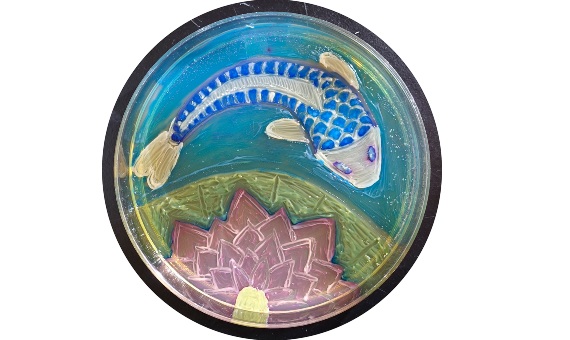
This year’s first place, for example, “Seemingly Simple Elegance”, a work created by Arwa Hadid, a student at Oakland University, portrays a Koi fish swimming on a lotus flower. The title refers to its apparent simplicity, yet hidden among its lines live nine different organisms. The centre of the lotus flower is made of Micrococcus luteus from which radiates Escherichia coli petals outlined with Staphylococcus saprophyticus to “add depth and colour to each individual stroke,” according to Hadid. Around this is a lotus leaf from Proteus vulgaris. The koi fish comes alive with Klebsiella pneumoniae whose colour is enhanced with Staphylococcus aureus, which outlines each individual scale and shapes the body. “A subtle orange tinge was given to the fins with Proteus mirabilis while the eyes are a piercing metallic blue haloed with red that is created by Citrobacter freundii. To encompass it all in calm blue water is Enterococcus faecalis.” As can be seen, the authors’ descriptions also deserve attention.
Tie for second place
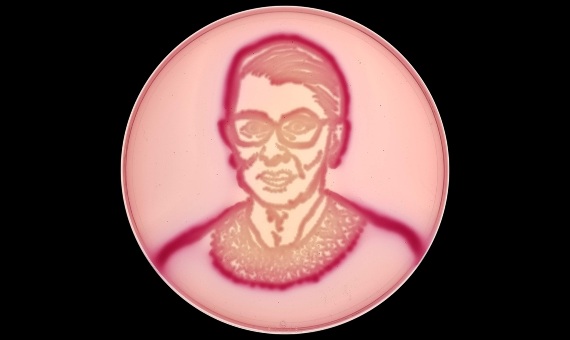
In second place there was a tie in this latest edition of the competition. On one side, there was the portrait of the US Supreme Court judge —the iconic Ruth Bader Ginsburg— “The Notorious R.B.G. on V.R.B.G.”, painted by Professor Michael E. Taveirne of North Carolina State University. Taveirne used the K-12 strain of Escherichia coli bacteria on agar with red and violet dye and a lot of glucose. Typically, this bacterium appears white; however, after fermenting the glucose found in the agar, it turns bright pink.
On the other side, sharing a prize with that portrait was a work that carries with it a health recommendation. “Ablution” created by Michael V. Magaogao —a laboratory technician at the Medical & Health Sciences University in the United Arab Emirates— portrays a desert landscape, with a camel and a date representing the arid, dry and water-stressed regions of the Middle East. Urinary tract infections are very common there, which helps to explain the organisms chosen: Staphylococcus aureus, Escherichia coli, Providencia stuartii and Proteus mirabilis, all of which are common pathogens of the urinary tract.
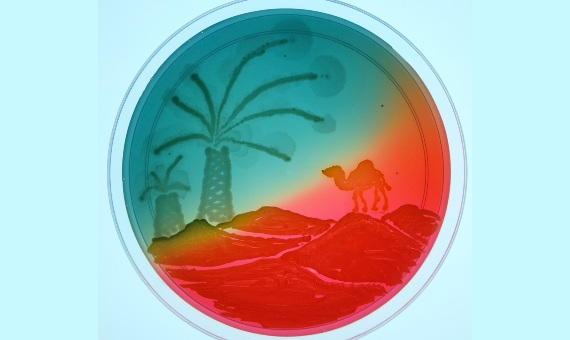
A Spanish student painting a Japanese scene
Third place was occupied by Isabel Franco Castillo of Spain for the work “Fu(n)ji-san”. This PhD student at the Institute of Materials Science of Aragon, took on the challenge of representing a volcanic eruption on an island in three dimensions: the lava descends down the mountainside to a beach with turquoise waters, under which delicate red corals can be seen. Franco used a food-isolated microorganism incubated on bright blue dyed agar for the corals and the sea.
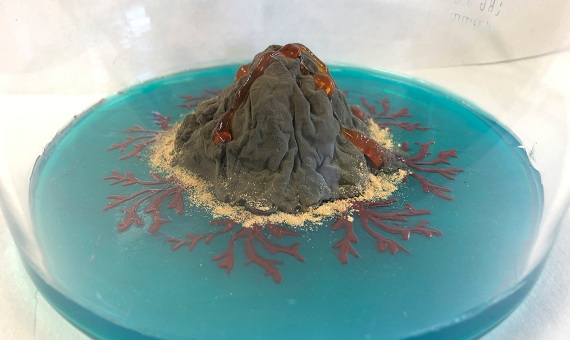
For the mountain she chose a special type of agar based on potato and dextrose inoculated with the Cladosporium cladosporioides mould. Franco made the lava that flows out of the crater the way children create stalagmites with sand from the beach: gradually dropping pieces of agar dyed with red food colouring. For the idyllic beach at the foot of the volcano she sprinkled beige spores of the Aspergillus ochraceus mould.
The success of the Agar Art Contest is such that similar contests have emerged in countries as diverse as Nepal and Bulgaria, and the Microbiology Association receives constant requests for this living art to appear in magazines, exhibitions and even in art degree curricula.
Comments on this publication